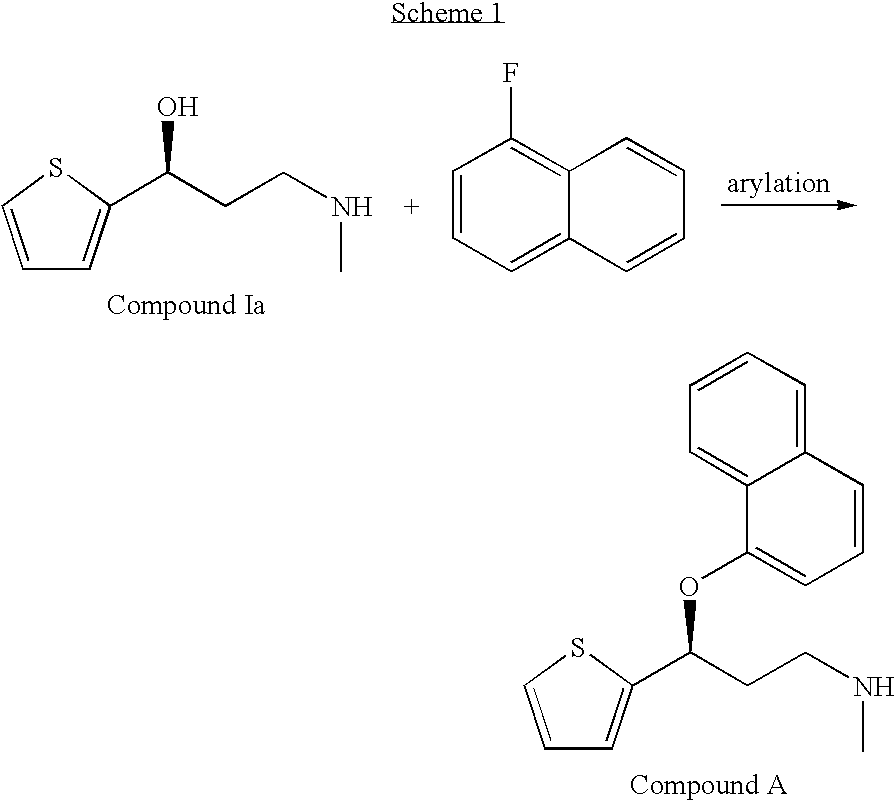Process for the asymmetric synthesis of duloxetine
a technology of asymmetric synthesis and duloxetine, applied in the field of pharmaceutical chemistry and synthetic organic chemistry, can solve the problems of high temperature, high temperature, and achieve the effect of low racemization and high amount of racemization
- Summary
- Abstract
- Description
- Claims
- Application Information
AI Technical Summary
Benefits of technology
Problems solved by technology
Method used
Image
Examples
example 1
Arylation of (S)-(−)-N,N-dimethyl-3(2-thienyl)-3-hydroxypropanamine
[0034]
[0035]To a 25 mL 3-neck round bottom flask equipped with a condenser, N2 inlet, thermocouple, and overhead stirrer charge Compound Ib (0.55 g, 3 mMol), powdered KOH (0.9 g, 14.2 mMol), diglyme (6 mL) and 1-fluoronaphthalene (0.5 mL). Heat the mixture with good agitation to 120° C. for 3 to 6 hrs. Cool to ambient temp. and dilute with water (6 mL) and EtOAc (6 mL). Separate layers, back extract aqueous with EtOAc (6 mL). Separate layers and combine organic layers. Place organic layers in a 25 mL 3-neck round bottom flask with overhead agitation. Slowly add 85% H3PO4 (0.25 mL). Seed after 10 drops have been added. Stir 5-15 minutes, complete acid addition and stir 1 hr. Filter and wash cake with EtOAc (10 mLs). Dry under reduced pressure to yield 1.0 g of the title compound. % ΔR:0.2. Monitor the % R enantiomer by chiral HPLC under the following conditions: Column; Diacel Chiralcel® OD-H, 5 micron silica, 4.6×250...
example 2
Arylation of (S)-3-Methylamino-1-(2-thienyl)-1-propanol
[0036]
[0037]Combine Compound Ia (10.0 g, 58.5 mmol), potassium hydroxide (14.7 g, 235 mmol), and 1-fluoronaphthalene (10.8 g, 74.0 mmol) in toluene (100 ml) and DMSO (10 ml). Heat to about 85° C. with agitation. After 12 hours, cool the resulting mixture to ambient temperature and carefully add water (100 ml). Separate the layers and wash the organic extract with additional water (50 ml). Separate the layers again and concentrate the remaining organic extract to provide a residue (19.0 g) of crude duloxetine free amine. % ΔR: 1.0. Monitor the % R enantiomer by chiral HPLC under the following conditions: Column; Diacel Chiralcel® OD-H, 5 micron silica, 4.6×250 mm internal diameter, 40° C.; Solvent: 83% hexane+0.1% DEA−17% isopropanol+0.1% DEA, 1 mL / min; detection UV 230 nm.
example 3
Arylation of (S)-3-Methylamino-1-(2-thienyl)-1-propanol
[0038]Charge a 250 ml reactor with Compound Ia (8.56 g, 0.05 mol), potassium hydroxide (12.5 g, 0.06 mol), toluene (100 m)l, 1-fluoronaphthalene (8.77 g, 0.06 mol) and DMSO (10 ml). Heat the resulting suspension to 85° C. over 30 minutes. After 8 h, cool the suspension to ambient temperature and add water (100 ml). Separate the layers and extract the aqueous layer with toluene (50 ml). Wash the combined organic layers with 15% aq. NaCl (50 ml) and concentrate. % ΔR: 2.2. Monitor the % R enantiomer by chiral HPLC under the following conditions: Column; Diacel Chiralcel® OD-H, 5 micron silica, 4.6×250 mm internal diameter, 40° C.; Solvent: 83% hexane+0.1% DEA−17% isopropanol+0.1% DEA, 1 mL / min; detection UV 220 nm.
PUM
| Property | Measurement | Unit |
|---|---|---|
| temperature | aaaaa | aaaaa |
| temperature | aaaaa | aaaaa |
| enantiomeric excess | aaaaa | aaaaa |
Abstract
Description
Claims
Application Information
 Login to View More
Login to View More - R&D
- Intellectual Property
- Life Sciences
- Materials
- Tech Scout
- Unparalleled Data Quality
- Higher Quality Content
- 60% Fewer Hallucinations
Browse by: Latest US Patents, China's latest patents, Technical Efficacy Thesaurus, Application Domain, Technology Topic, Popular Technical Reports.
© 2025 PatSnap. All rights reserved.Legal|Privacy policy|Modern Slavery Act Transparency Statement|Sitemap|About US| Contact US: help@patsnap.com



